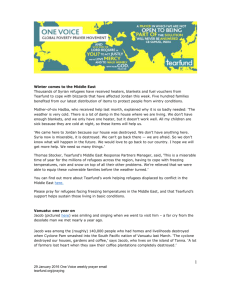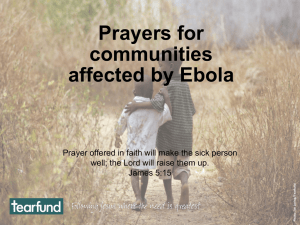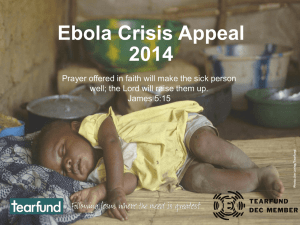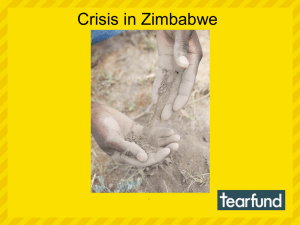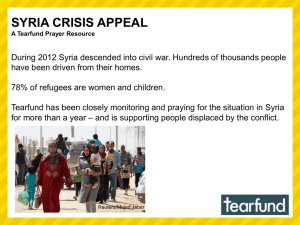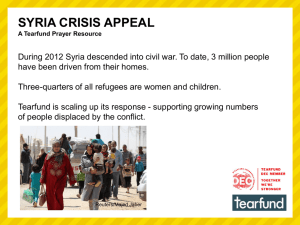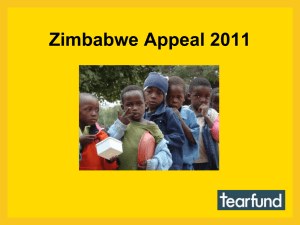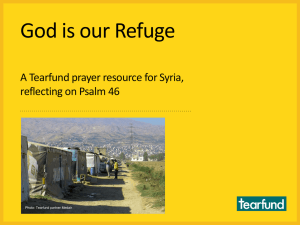Micah Network Emergency Response Proposal Guidelines
advertisement
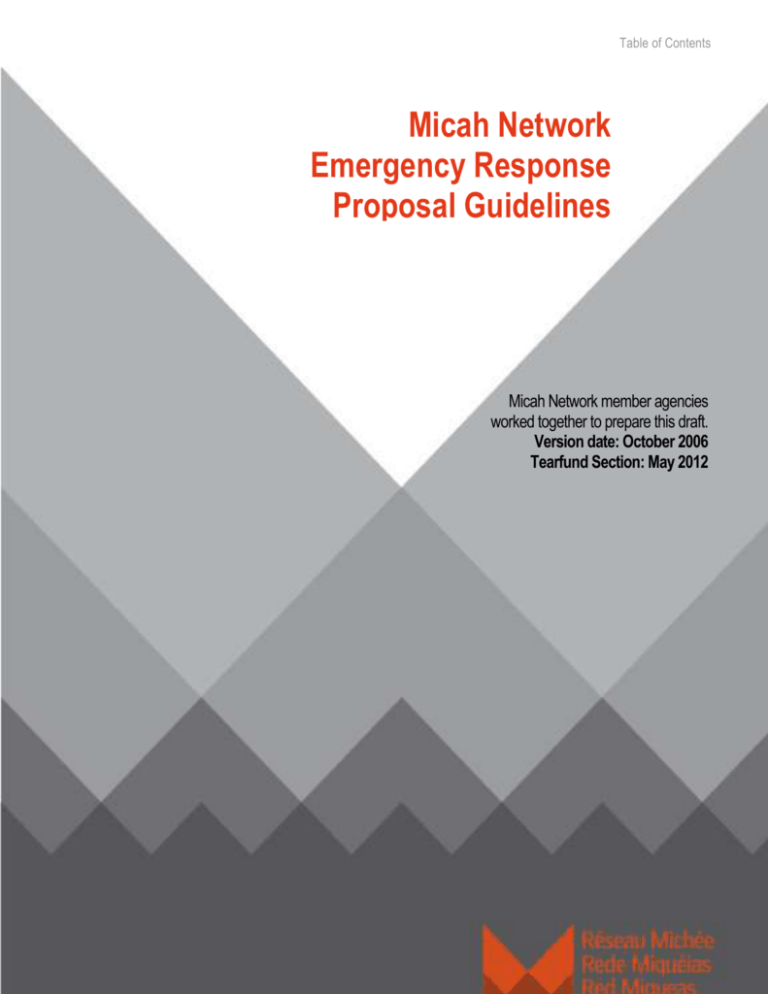
Table of Contents Micah Network Emergency Response Proposal Guidelines Micah Network member agencies worked together to prepare this draft. Version date: October 2006 Tearfund Section: May 2012 Micah Network Emergency Response Proposal Guidelines (Version date: Oct 2006, Tearfund May 2012) i Table of Contents Contents 1. Introduction 1 2. The Format for Narrative Proposals 2 3. The Format for Logical Framework Matrices 6 4. The Format for Programme Budgets 7 5. Bank Details 12 6. Glossary 13 Annexure 1: Supporting Partner Application Procedures 14 Annexure 2: Differing Requirements 15 Annexure 3: International Standards 19 Annexure 4: Example of Good Practice Proposal 20 Micah Network Emergency Response Proposal Guidelines (Version date: Oct 2006, Tearfund May 2012) i Table of Contents 1. Introduction 1.1 Background—These Emergency Response Proposal Guidelines have been jointly developed by a group of Implementing Partners and Supporting Partners within the Micah Network, over an 18 month period. The process started following a “strategic consultation” on partnership at which Supporting Partners heard the concerns from Implementing Partners about the administrative burden caused by differing proposal and reporting requirements. Two regional working groups of Implementing Partners (in Asia and Africa) and a working group of Supporting Partners were established to participate in the process and to develop the draft documents. All Micah Network members were invited to provide comments and suggestions prior to finalisation of the Guidelines. 1.2 Projects and programmes—Proposal and reporting guidelines often refer to both “programmes” and “projects”. For simplicity, the word “programmes” has been used throughout the Guidelines, but should be understood to include both “programmes” and “projects”. 1.3 Application procedures—Supporting partners who have adopted these Guidelines will continue to follow their own application procedures. Please refer to these in Annexure 1 prior to submitting the proposal for details. Each supporting partner has their own priorities and strategies in place and will need to assess the proposal in the context of those priorities and strategies. It is suggested that Implementing Partners contact the relevant Supporting Partner for details of country strategies and sectoral priorities prior to submitting a proposal. 1.4 Differing requirements—These Guidelines and the underlying proposal format are expected to cover most, and in some cases all that the Supporting Partner needs to know to decide on funding. Where the Supporting Partner has additional or reduced requirements they will give details and guidelines in Annexure 2. 1.5 Questions not applicable—Some questions may not be relevant to the context in which the Implementing Partner is working. Please mention this in the relevant section of the proposal, explaining why the question(s) do not apply. 1.6 Glossary—A Glossary section explaining the meaning of key terms can be found on page 13. References to “Supporting Partner” should be interpreted as the organisation from whom assistance is requested for the programme, and references to “Implementing Partner” should be interpreted as the organisation applying for such assistance. 1.7 Example Proposal -A “good practice” example of and Emergency Response Proposal is set out in Annexure 4. 1.8 Comments or suggestions—If you would like to make comments on these Guidelines, please send them to your Supporting Partner and to the following address: Micah Network International Secretariat E-mail: ic@micahnetwork.org Fax: + 613 9877 7944 Post: PO Box 164, Blackburn Victoria, Australia Micah Network Emergency Response Proposal Guidelines (Version date: Oct 2006, Tearfund May 2012) i The Formal for Narrative Proposal 2. The Format for Narrative Proposal An Emergency Response Proposal will need to provide sufficient information to enable the Supporting Partner to quickly reach a funding decision. Its purpose is to explain how the design of the programme is likely to bring about the changes to which the Implementing Partner and the Supporting Partner are committed and how it embodies good practice1. The Proposal must be no longer than 10 sides of A4 including logframe and budget (but excluding other appendices). The font size should be no less than Arial Narrow 12 point. To facilitate the proposal writing in line with these Guidelines, the Implementing Partner may use the “Micah Network Emergency Response Proposal Template” which can be downloaded from the Micah Network website www.micahnetwork.org. Section A Basic Information (maximum one page) 1. The programme title and the Supporting Partner programme reference number (if applicable). 2. The name of the Implementing Partner requesting funding. 3. Description of the programme (maximum 100 words). 4. The name, role, office address, phone, fax and e-mail of the Implementing Partner contact person and the website of the Implementing Partner (if any). 5. The name, designation and role of the person approving the application for the Implementing Partner. This person must be duly authorised by the Implementing Partner 2. 6. The planned start date of the programme and its duration. 7. The location of the programme area. (Name of district / city / town / region); a map showing the location can be annexed. 8. List the international standards which the Implementing Partner has adopted to guide its practice in relief programmes (eg Red Cross Code of Conduct, SPHERE, Humanitarian Accountability Partnership—International (HAP-I), People in Aid etc). 9. The name(s) of any other implementing partner(s) who will be involved in the programme with the Implementing Partner3. 10. The overall budget of the programme and the amount in local currency that the Implementing Partner is requesting from this and other Supporting Partners and other contributions as set out in the table below. Activity Year Period 1 Period 2 Period 3 Supporting Partner Other supporting partners Local and Other Income Total 1 In developing the proposal, you may find it helpful to refer to the growing body of international standards applying in our sector, some of which are referred to in Annexure 3. 2 In the case of any doubt, the Supporting Partner may ask for evidence of the authority. 3 A list of key international standards for emergency response situations are set out in Annexure 3. Micah Network Emergency Response Proposal Guidelines (Version date: October 2006) 2 The Formal for Narrative Proposal 11. The date that the proposal was written (or date of latest revision). Section B Information about the Disaster (maximum one page) Nature of Disaster 1. What is the nature of the disaster? 2. What is the area affected by the disaster? 3. Who are the vulnerable groups affected? Impact of Disaster Section C 1. What is the extent of damage or impact (estimated size of population affected)? 2. What are the main problems the people are facing? (eg health, water and sanitation, food aid, shelter, protection, displacement, livelihoods) 3. What was the process and findings of the need assessment conducted? (Attach report if available.) Emergency Response Design (maximum one page) 1. What specific area and/or group have you chosen for the programme? How did you make this choice? 2. What interventions are you planning to make: i. immediately, ii. in the medium term, Please indicate: • the timing for the different phases of the programme • the number of targeted beneficiaries for the programme • how the beneficiaries are to be selected. 3. Please indicate what resources are needed: • Materials (What materials, where will they be sourced and how delivered? Specify any materials which need to be delivered in-kind and those which can be purchased locally.) • Human and Other Resources (explain personnel, equipment, etc) • Other 4. Is there an intention at this stage for longer term rehabilitation and development programming? 5. How has the community been involved in determining the purpose of this programme? How will programme information be shared with the community? How will beneficiaries be enabled to make comments (positive and/or negative) about the programme without fear or hindrance, and with the assurance that their comments will be taken into account? Micah Network Emergency Response Proposal Guidelines (Version date: October 2006) 3 The Formal for Narrative Proposal 6. What other projects/programmes are being undertaken, and by whom (government, NGOs, local churches and other community groups, etc)? How will you coordinate with those working in your area of operation? 7. How will the programme reduce the community’s vulnerability to future disaster situations or events and what percentage of the budget will be used for this? Section D Programme Logframe (maximum one page) Section E Programme Approach and Justification (maximum one page) A Logical Framework Matrix is required explaining the linkage between activities, outputs and purposes of the programme. A suggested format is as specified in section 3 but the Implementing Partner may use an alternative layout if preferred and agreed with the Supporting Partner. Please answer questions about the methodology that will be used in implementing the programme. 1. Explain why the Implementing Partner considers the programme approach or methodology to be the most effective way of addressing the problem(s). What other approaches were considered and why were these rejected? 2. What lessons related to this programme have been applied from past experience? Has the programme or its predecessor been recently evaluated? If so, include the executive summary and recommendations in the appendices together with an explanation of how these recommendations have influenced or been applied to the current design. 3. How have the following cross-cutting issues been addressed in programme design? • gender issues and the differences in status of women and men • the special needs of children • people with impairment and/or disabilities • conflict • people affected and infected by HIV Section F Programme Management (maximum one page) Please answer questions about the management of the programme, in particular monitoring and evaluation. 1. What previous experience or involvement does the Implementing Partner have in the programme area or in this type of programme? 2. Who will be directly responsible for overseeing the management of the programme? Indicate the management structure for the programme and how it relates to the organisational structure (an organogram may be added as an annexure). 3. What additional demands will the programme make on the existing leadership and management capacity of the Implementing Partner? How will the Implementing Partner deploy resources and / or build capacity to meet these new demands? How will involvement in this programme affect existing long term development programming? Micah Network Emergency Response Proposal Guidelines (Version date: October 2006) 4 The Formal for Narrative Proposal Section G 4. Describe the Implementing Partner’s procurement procedure and any particular systems for the protection of materials and cash in the field. 5. Describe the monitoring systems that are in place or will be developed to assess the progress and achievement of the programme. If available, please attach a sample format. 6. Are you planning a formal evaluation of the programme? If so, what type of evaluation do you envisage and when and how will it be carried out? Risk Assessment and Management (maximum one page) List the most significant assumptions or risks (not more than 10) and for each of these identify the measures that will be taken to reduce or minimise the risk. Micah Network Emergency Response Proposal Guidelines (Version date: October 2006) 5 The Formal for Narrative Proposal 3. The Format for Logical Framework Matrix (Maximum one page) The following format for the Logical Framework Matrix (logframe) is suggested but you may also use an alternative layout if preferred and agreed with the potential supporting partner: Objectives Indicators Goal • What does the Implementing Partner ultimately want to achieve through the programme? • What will indicate whether the purpose has been achieved? Purposes • What is the specific change or changes that the Implementing Partner • What will indicate whether the purpose expects to take place as a result of the programme? has been achieved? • The purpose should be specified in terms of quality and quantity (what change will take place), location (where the change will take place), and timing (when the change will take place). Outputs • What are the products that programme activities will generate during the lifetime of the programme? • The outputs should contribute to the achievement of the programme’s purpose. They may be thought of as visible markers or milestones which show that the Implementing Partner has carried out the activities (see below) successfully. • What will indicate whether the outputs have been achieved? Activities • What are the main activities which the Implementing Partner will carry out during the lifetime of the programme? The activities are the things the Implementing Partner will do in order to deliver the outputs. • Each activity should be clearly related to at least one of the outputs. Micah Network Emergency Response Proposal Guidelines (Version date: Oct 2006 Tearfund May 2012) 6 The Formal for Programme Budgets 4. 4.1 The Format for Programme Budgets (Maximum two pages) A detailed programme budget goes together with the programme proposal. The purpose of the Programme Budget is: a) to help the Supporting Partner allocate the requested funds from the resources available. b) to provide a working plan against which the financial progress of the programme can be measured. 4.2 The budget should be for the whole programme, not just the parts for which the Implementing Partner is requesting a grant from the Supporting Partner. Please read the guidance notes in each section before completing the budget. The budget documents should include: a) an indication of the period covered. b) a detailed budget showing how the various Operational/Programme Costs and Capital Costs have been calculated. 4.3 Please present the budget in local currency and if required by the Supporting Partner, please also submit the budget in the currency of the Supporting Partner (eg Pounds Sterling, Euros, US Dollars or Australian Dollars). In certain circumstances (eg hyper-inflation, country situation) it might not be possible or reasonable for the budget to be prepared in local currency. In that case the budget can be prepared in another currency (eg Pounds Sterling, Euros, US Dollars, Australian Dollars) in accordance with any additional instructions from the Supporting Partner. 4.4 Costs The budget (section 4.14) should show the calculations of the Operational/Programme Costs and any Capital costs. This should show the basis of calculation using unit prices, salary rates, proportion of time allocated to the programme, kilometre rates for vehicles, number of units required etc. as appropriate. Budget headings should match the account descriptions in the accounting system of the Implementing Partner so that financial reports will be accurate and consistent. It will help the programme and accounting staff if the accounting system analysis code is shown against each budget heading. 4.5 Please distinguish between Direct Costs and Indirect Costs. See Glossary for definition of these terms. 4.6 Inflation may be included as a separate item in exceptional cases, but the calculation must be explained. 4.7 After approval, no more than 10% of the concerned budget heading can be moved from one budget heading to another unless the amount involved is less than US $ 500. Movements of more than 10% must be negotiated with the Supporting Partner. The Supporting Partner must be consulted before moving any funds to capital cost budget lines. Micah Network Emergency Response Proposal Guidelines (Version date: Oct 2006 Tearfund May 2012) 7 The Formal for Programme Budgets 4.8 Guidance Notes on Operational/Programme Costs Where applicable, please cross-reference the budgeted costs to the sections of the programme proposal which explain the programme’s main activities (eg the Activities section of the Logical Framework), so that it is clear which costs apply to which activities. Direct Costs Activity and material costs: This should include all consumable items (eg building materials, food, education materials) required for programme activities, showing estimated prices and quantities. Staff costs / salaries: Include the costs of employing all staff who work directly on the programme. Please ensure that the cost of social security, health insurance and pension/superannuation/provident fund contributions are included if appropriate. Where salaries are not itemised, a statement of the level of the highest salary should be given per year or per month. Do not include staff training costs under this budget heading; instead show them as a separate item. Transport costs: Include any costs incurred in moving people or equipment on the programme. If vehicles are to be purchased from programme funds, the actual running costs (fuel, maintenance and insurance) of those vehicles should be budgeted. Where vehicles already owned by the Implementing Partner are ‘hired’ for use in the programme, a mileage/kilometre rate should be set covering the cost of fuel, maintenance, insurance and capital depreciation. In this case, budget for the estimated mileage rather than the actual costs. Do not use this budget heading for the purchase of vehicles; instead, show this as a capital cost. Premises costs: Include rent, taxes and utility costs (electricity, water) for the building(s) associated with the programme. The cost of any refurbishment or new building work required should be included as a Capital Cost. You may include the running costs of a field administration office if directly associated with the programme, but a claim for a contribution to the costs of running the head office or general administrative centre should be made under Administration costs (see below). Monitoring costs: The ongoing monitoring of activities and the collection of data for use in evaluating results, is an essential part of all programmes. You should budget for any direct costs of monitoring and collecting data which are over and above otherwise covered staff costs/salaries separately, rather than having to cover this out of general administration charges. Evaluation costs: It is good practice to evaluate programmes, and the costs for conducting an evaluation should be included. Include consultants’ fees, travelling expenses, and the extra costs of conducting surveys, workshops and production of reports. Indirect Costs Administration costs: You may claim a contribution towards the administrative running costs of the Implementing Partner (central management and administration salaries, office supplies, telecommunications, office rent and utilities, audit and Board expenses, depreciation of capital assets etc). This is normally restricted to 10% of the total Direct Operational/Programme Costs of the programme. Micah Network Emergency Response Proposal Guidelines (Version date: Oct 2006 Tearfund May 2012) 8 The Formal for Programme Budgets In cases where the Implementing Partner considers that the actual costs of supporting the programme will exceed this amount, a separate detailed budget for central administration costs in justification of a claim for a higher administration charge may be submitted. The administration budget must show clearly the total costs of administering the Implementing Partner (ie. all the Indirect Costs), the sources of income available to set against those costs, and how and why you divided up the balance between the different programmes to be managed by the Implementing Partner. For further information on how to fund core costs, see the guidance note on Core Funding Strategies on www.bond.org.uk/pubs/afo.htm 4.9 Guidance Notes on Capital Costs Supporting Partners can fund the capital costs of programmes, but please note that funding from Supporting Partners is not primarily intended for major capital outlay such as the purchase or building of premises, or purchase of vehicles. Vehicles / Programme Equipment: Please provide evidence that these items: • are essential for programme implementation • will be used on programme activities only, and not assigned for the exclusive use of an individual • are properly maintained and insured and that you have a policy for the disposal of the vehicles or equipment at the end of the programme. If you are seeking funding for vehicles and equipment, please attach to the programme budget the Implementing Partner’s policy for the disposal of vehicles and equipment. The Supporting Partner may also require an asset register to be kept. Office Equipment: Include items such as computers or fax machines. Other: Include any costs not already listed. You must specify what the cost is for, if you enter an amount under this budget heading. Note: Budgeting for the replacement of capital items is good financial management. It is acceptable for the programme budget to include the cost of using capital assets belonging to the Implementing Partner and for those costs to include an element of depreciation. Depreciation should be treated as part of the administration costs and should not be included as a separate budget line. 4.10 Unacceptable Costs Supporting Partners do not pay “per diems” (daily payments) for participants attending workshops and seminars, but will cover the actual expenses incurred by participants (e.g. travel costs), although some form of local contribution towards these expenses is expected. 4.11 Unforeseen costs arising during the programme implementation will be considered on a case by case basis and so Contingency Funds will not normally be allowed. However, for large capital programmes, unforeseen costs up to a maximum of 10% of the total programme budget may be included. 4.12 Except in exceptional circumstances Supporting Partners do not fund the salary and support costs of expatriate staff from other international agencies (e.g. European or North American) working overseas. Micah Network Emergency Response Proposal Guidelines (Version date: Oct 2006 Tearfund May 2012) 9 The Formal for Programme Budgets 4.13 Income You should enter all sources of income that you will use to meet the costs of the programme. These may include: Other agencies/government: Include anticipated income from other agencies and government departments. Please indicate whether the application has been submitted, approved or the money already received. In-kind donations: These are items that make a contribution to the costs of the programme but are given at no cost to the programme, for example labour and materials provided by the beneficiary group, or food and equipment provided by a donor. Where possible please provide estimates of the cash value of these donations. In-kind donations must be identified with the corresponding programme costs. Income generated by the programme: Include income from programme users, for example through the sales of goods or services. Balances: Balances carried forward from a previous cycle of the programme should be estimated (if applicable) and included here. Reserves: Please indicate if you are intending to use any of the Implementing Partner’s organisation’s own reserves to support the programme. Note: Schedule of Activities and Fund Release Schedule. A fund release schedule based on schedule of activities and programme cash flow requirements of the programme should be submitted along with the budget. 4.14 Please attach total proposed budget and amount requested from the Supporting Partner, using the sample template below. Please give breakdown of each section. Micah Network Emergency Response Proposal Guidelines (Version date: Oct 2006 Tearfund May 2012) 10 The Formal for Programme Budgets Expenditure Items Unit cost No of units Total Amount from Notes and supporting explanations partner Activity and material costs (Relief inputs) Personnel and related costs Transport and logistics costs Capital costs Evaluation costs Field support costs – administration and communications Head Office support costs (limits may be applied by the Supporting Partner) Other costs Total Expenditure Income Name other donors/describe sources of income Amount Amount Committed Requested/Expected Supporting Partner supporting partner 2 supporting partner 3 supporting partner 4 Other donors In-kind donations Local contributions Other (please specify) Total Income Micah Network Emergency Response Proposal Guidelines (Version date: Oct 2006 Tearfund May 2012) 11 The Formal for Programme Budgets 5. Bank Details (Maximum one half page) If the proposal is successful, the Supporting Partner will require details of the bank account where money should be transferred. To ensure that money is transferred with the minimum of delay, please provide all the details outlined below. If money needs to be routed via a ‘corresponding bank’ (i.e., a third party bank) then you also need to provide all the information with an asterisk for the corresponding bank. Detail Explanatory Note Account Name The name of the Implementing Partner as it appears on the bank account; this will be the account into which the Supporting Partner transfers money. Account Number The Implementing Partner’s account number; this will be the account into which the Supporting Partner transfers money. Bank Swift Code/BIC number (if known) The Swift Code or BIC number can reduce delays in making payments to the account. If the bank or corresponding bank is in America the Fed Wire/ ABA number must be provided. If the bank/ corresponding bank is in Europe the IBAN number must be provided. Currency of Bank Account The currency in which the account is held (e.g. local currency, US Dollars). Name of Bank The name of the bank. Address of Bank The full postal address of the bank, including the city, state and country. Address of Organisation The full postal address of the Implementing Partner, including the city, state and country. E-mail Address of Organisation Your e-mail address; this allows the paying bank to notify the Implementing Partner that payment has been made to the account. Micah Network Emergency Response Proposal Guidelines (Version date: Oct 2006 Tearfund May 2012) 12 The Formal for Programme Budgets 5. Glossary activities are the actual tasks to be done to achieve the desired outputs. direct costs are those that are wholly attributable to the programme in question and which are only incurred because of the programme’s existence. These are usually related to the carrying out of the main activities (eg: programme workers’ salaries, supplies for beneficiaries, transportation costs) but will also include monitoring and evaluation costs. The basis of calculating these costs should be clearly shown. evaluation means an assessment carried out during, or after, the end of a programme to show its impact. goal means the wider development objective—the ultimate result toward which the programme is contributing. impact means long term sustainable changes—positive or negative, expected or unexpected which occur in the context in which the programme operates. Implementing Partner means the organisation applying for support under these Guidelines and who will be responsible for the direct implementation of programme activities. indicators (referred to as objectively verifiable indicators) are ways of measuring progress toward the goal. They are targets or standards to be met at every stage. indirect costs are those that are shared across different programmes or departments of the Implementing Partner and are incurred independently from the programme. They normally relate to the management support of the programme (eg: central office facilities, central management salaries, accountancy and audit) and are often covered by an administration fee charged to the programme. The basis on which these costs are allocated to projects/programmes should be shown. monitoring means a structured and continuous process of measuring progress towards objectives. objectives is a general word used for desired changes or results; within the lifetime of a programme eg outputs; on completion of a programme eg purpose or outcome; or a time after the programme eg goal. outputs means the products or work targets needed to be done to achieve the programme purposes or outcomes. programmes are a planned, coordinated group of activities, procedures, etc. , to achieve a particular goal. projects are ‘stand alone’ activities aimed at a limited outcome. A number or series of such projects can be the components of a programme. purposes means the specific change(s) that a programme will contribute to the goal. stakeholder means a person, group or institution with an interest or concern in something, eg in a programme, policy or initiative. Supporting Partner means the organisation for which the proposal is being prepared, with a view to that organisation providing financial and other support for the programme. Micah Network Emergency Response Proposal Guidelines (Version date: Oct 2006 Tearfund May 2012) 13 The Formal for Programme Budgets Annexure 1: Supporting Partner’s Application Procedures 2.1 2.2 2.3 Partnership Applications can only be approved for organisations who have been adopted by Tearfund as Partners. Organisations seeking partnership in order to obtain emergency response funding must complete Tearfund’s Partner Profile Form and sign a Partnership Agreement as soon as possible during the application process. Project Concept As soon as possible discuss the concept for an emergency response project with the Tearfund Representative responsible for your country. The Country Representative will let you know informally whether the concept is within Tearfund’s strategy and if it has been possible to allocate funds for emergency response. Project proposal If we approve your concept we will ask you to prepare a Proposal and, if necessary, offer support to enable a more detailed needs assessment to be undertaken with the beneficiary communities as part of the preparation of the Proposal. Where the proposal is for £100,000 or more, Tearfund will seek compliance with its Quality Standards in the project design – see Annexure 3. Please use the Emergency Response Proposal Template together with the additional information described in Annex 2 of the Emergency Response Proposal Guidelines. If a needs assessment was funded by Tearfund as part of the application process, this report should be attached to the Full Proposal as an appendix. 2.4 Electronic communication and documents Your application will be dealt with more quickly if you can submit documents by email. Please complete the Templates using Microsoft Word and Excel. 2.5 Caution Please note that if we invite you to submit a Proposal, this is not a guarantee that your project will be approved and that you will receive Tearfund support. It is therefore important while you are going through the application process that you do not enter into any formal commitments, or undertake any project activities, which are dependent on Tearfund funding or raise the expectations of your project beneficiaries on the assumption that you will receive Tearfund funding. 2.6 Release of funds We will respond to your application as quickly as possible. If it is accepted you will be notified by your Country Representative and by means of a Payment Letter which will clearly show how much has been approved, when it will be released and what the reporting dates will be. Partnership negotiation Discuss project idea with Tearfund Tearfund request for a Proposal Submit a Proposal using the Emergency Response Proposal template Await Tearfund’s decision Release of funds – written notification Micah Network Emergency Response Proposal Guidelines (Version date: Oct 2006 Tearfund May 2012) 14 The Formal for Programme Budgets Micah Network Emergency Response Proposal Guidelines (Version date: Oct 2006 Tearfund May 2012) 15 Annexure Annexure 2: Differing Requirements Tearfund requires the following information in addition to the sections in the standard template in order to a) assess the scope of work to be done in this project by and through the local church b) gather data on the number of beneficiaries reached so that it can measure progress towards achieving its long term vision. Additional guidance is also provided for completing Section E of the proposal on issues that are a priority for Tearfund c) People affected and infected by HIV d) Environmental Sustainability a) The Local Church Tearfund’s long term vision is to see people lifted out of extreme poverty and to see their lives and communities transformed through the work and witness of Christians and local churches. In addition to the standard proposal sections the following questions should be addressed in an Annex to the main proposal: Section K Local Church Mobilisation and Christian Witness 1. In what ways will the project contribute to the envisioning of local churches for Integral Mission and encourage their commitment to Jesus Christ, in discipleship and in their service of the poor? 2. Will the project provide opportunities, appropriate to the context, for people to encounter, acknowledge and follow the lordship of Jesus Christ through its work? Will these opportunities be linked to the witness of the local church? 3. Where there is no local church in the communities where the project will be working, will the project help to contribute in any way to the longer-term establishment of a sustainable Christian community in the area? In the proposal please estimate the number of new churches to be mobilised during each year of the project. Partners will be asked to report, on an annual basis, the number of local churches that they work with in envisioning people for Integral Mission, and the number of churches that are mobilised to serve the poor in their community. This data will be collected through the Transformational Indicators Report which can be seen in the reporting Guidelines. For the purpose of the Transformational Indicators Report: ‘Local Churches’ are “Sustainable communities of local Christian believers, accessible to all, where worship, Micah Network Emergency Response Proposal Guidelines (Version date: Oct 2006, Tearfund May 2012) 16 Annexure discipleship, nurture and mission take place” Sustainable – not reliant on outside funding, personnel or resources for its existence Communities – not isolated individuals Local – not outsiders but people who live in the community Accessible to all – the poor and marginalised are welcomed and included In most instances, such Christian communities will be local church congregations, whether these are formal congregations as part of a larger church network or denomination, or independent informal groups of Christians who meet regularly in someone’s home or other facility. ‘Envisioning’ means a process of teaching, discussion and encouragement designed to inspire the Christian community to practice Integral Mission, with or without external support. A ‘mobilised church’ is: A church that has been exposed to Integral Mission thinking as a result of a Tearfund resourced initiative and, as a consequence, is active in practical service to the community (whether or not that service is resourced/ funded by Tearfund). b) Number of beneficiaries served – ref. section C4 (C1 simplified format, C2 emergency) Tearfund has a responsibility to measure and report the impact of what is achieved in outworking its vision with the resources provided by its donors. Part of that impact is measured in terms of the number of people benefiting from funded programmes and also the number of churches mobilised to serve their communities. Section L Beneficiaries Forecast numbers Partners are required to state the forecast numbers of beneficiaries to be served during each year of this project and which of these are new to the project each year. Tearfund will measure progress towards its long term goals over a period of years and it is vital that beneficiaries are not counted more than once where they participate in more than one project. Accordingly partners are asked to state the number of beneficiaries who have already been taken into account in other Tearfund supported projects. Partners are also required to provide, for the whole project, a breakdown between men, women, boys under 18 years old, and girls under 18 years old. To assess Tearfund’s impact across priority sectors, beneficiary numbers for each priority sector for the whole project are required to be estimated. Method of counting beneficiaries 1. Explain briefly how the expected number of beneficiaries has been calculated, and who has been included in the total (see section 3 below for guidance) (eg. Detailed survey / estimate based on sample survey / official figures / pure estimate etc.) Micah Network Emergency Response Proposal Guidelines (Version date: Oct 2006, Tearfund May 2012) 17 Annexure In your annual reports you will be required to submit figures for the actual number of people benefiting from the project during the year, as above. (See the Transformational Indicators Report in the Tearfund annex to the reporting guidelines). 2. Explain the method you will use to quantify the number of beneficiaries for reporting in the Transformational Indicators Report (eg. Registers, survey, official records etc.) and analyse the percentage of men, women and children in the beneficiary group. Direct and indirect beneficiaries – who to include For the purposes of the Statistical Return the number of beneficiaries reported will normally include all the members of the Household to which a direct participant in the programme belongs. (Note: in order to report fully on the Outputs and Activities of a project, statistics may still need to be compiled on the number of direct participants, depending on the nature of the work.) Some work will, by its nature, be directed at households within communities. Eg. Provision of public and domestic services like water, roads, shelter, health and education facilities, food security. Other work will provide direct inputs to certain individuals within a household, but it is the whole household that ultimately benefits. Eg. Skills training, adult literacy, children’s education, livelihoods support, health treatment. However there may be some exceptions where a household approach will not apply – only the individual receives a benefit. For example Emergency nutrition, displaced people groups, orphans and abandoned children, c) Priority Issues – People affected and infected by HIV – ref. section E3 Globally, the prevalence of HIV is increasing. There are over 40 million people living with HIV worldwide. The impact of the pandemic is long lasting and it continues to dramatically impact poor communities. Tearfund’s vision is to see local churches across the world mobilised, envisioned, and resourced to be at the forefront of the response. How have the rights and special needs of people living with HIV been taken into account in the programme design? All proposals must consider how the impact of HIV in the community may affect the implementation and results of the project. For projects specifically addressing the causes and effects of HIV please consider how the programme will reduce vulnerability and the impact of HIV and AIDS. The following areas are a priority for Tearfund: - Facilitating behaviour change among children and young people - Preventing mother to child transmission - Reducing the impact on people living with and affected by HIV, specifically women and children - Promoting access to treatment for opportunistic infections and antiretroviral therapy - Ending stigma and discrimination of people living with and affected by HIV Micah Network Emergency Response Proposal Guidelines (Version date: Oct 2006, Tearfund May 2012) 18 Annexure d) Priority Issues – Environmental Sustainability – ref. section E3 Environmental instability due to resource depletion and climate change is predicted to stand out above most other issues that undermine future development efforts. We seek to reduce the impact of Tearfund, our partners and supporters on the environment, to restore environmental resources and poor people’s access to them, and to reduce the vulnerability of poor people to environmental hazards. How will the programme impact on the local environment? Here consider any negative impacts of the project activities on: - water resources (e.g. depletion, pollution of domestic water supplies, rivers, lakes, sea) - land (e.g. sustainable land use, soil erosion) - air (e.g. pollution) - wildlife (e.g. grazing/roaming patterns, habitat removal) - vegetation (e.g. forest, ground cover, agricultural production) - waste (e.g. dangerous, unnecessary, non-reusable or non-recyclable waste) Where applicable, what steps will be taken to assist environmental restoration and enhance environmental sustainability in the programme area? Here, outline: - any positive impacts that the project will have on the local environment. - the steps that will be taken to overcome the negative impacts identified in the previous question. For example, could waste be reduced, reused or recycled? If wood is used to build latrines, could it be sourced from sustainable forests? Could visits to the project site be reduced or could less polluting forms of transport be used? Vulnerability to disasters In this section please also consider any current effects or future risks arising as a result of climate change that pose a threat to the project or the beneficiary group. Micah Network Emergency Response Proposal Guidelines (Version date: Oct 2006, Tearfund May 2012) 19 Annexure Annexure 3: Blank Annexure 4: Example of Good Practice Proposal [It is intended that an example of a good Emergency Response Proposal together with budget and logframe be inserted here, prior to roll out of the guidelines in early 2007.] Micah Network Emergency Response Proposal Guidelines (Version date: Oct 2006, Tearfund May 2012) 20


